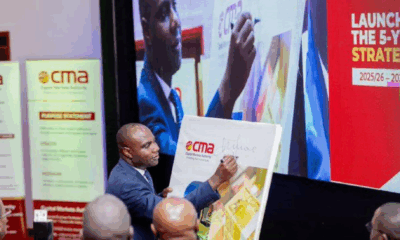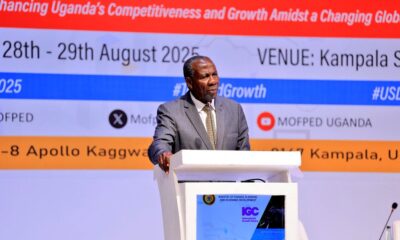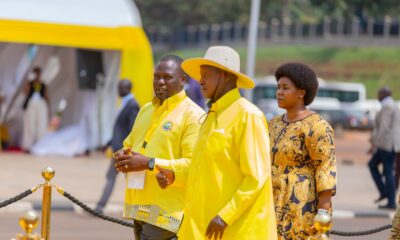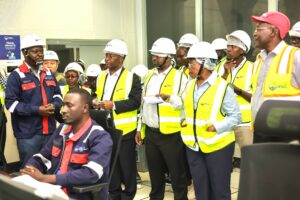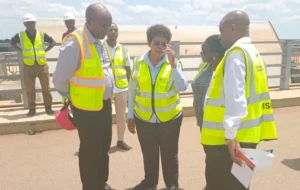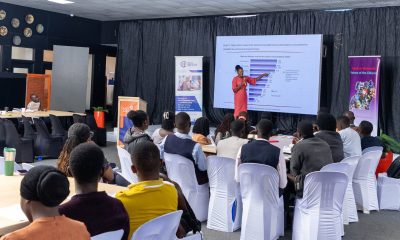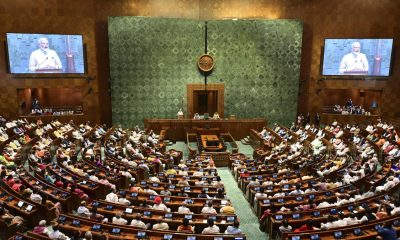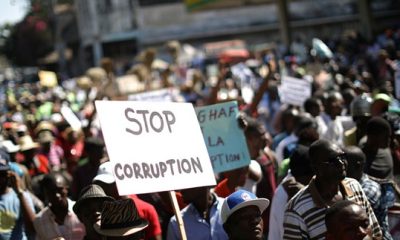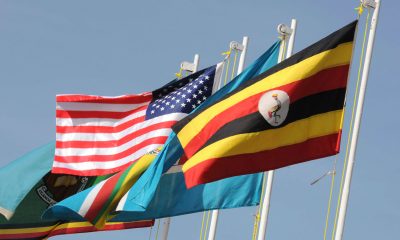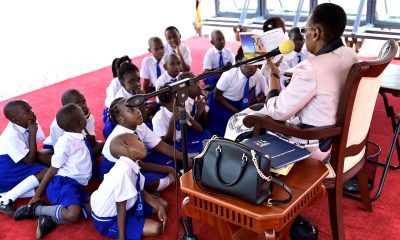Analysis
‘Shoddy’ Shs 2 trillion Isimba dam could be washed away soon – experts
The Inspector General of Government (IGG), Beti Kamya, has launched a formal investigation into alleged shoddy construction works at the 183mw Isimba hydropower dam along the River Nile.
The probe follows years of growing public concern over accountability and the structural integrity of the over Shs 2 trillion project located in Kayunga district. Kamya’s intervention comes amidst fears that the project, completed just five years ago, is already showing signs of significant defects, putting both infrastructure and nearby communities at risk.
There are fears that the dam could soon be “washed away” by flooding. The IGG and her investigative team visited the dam on Friday, interacting with officials from Uganda Electricity Generation Company Limited (UEGCL), representatives from the Attorney General’s office, and the ministry of Energy.
“I can see that there are some quality issues. Especially with the structure. To me, it looks like a very old structure. Instead of a structure that is about five years old,” she said.
The dam is owned by Uganda Electricity Generation Company Limited (UEGCL) on behalf of the government of Uganda. China International Water and Electric Corporation (CIWE) was contracted to construct the dam.
Concerns over structural integrity
While the dam currently generates its full capacity of 183 MW, the IGG was informed that the spillway, a crucial safety component designed to manage floodwaters, has severe structural flaws.
The spillway’s damage became evident after the August 2022 flooding, which compromised its integrity and functionality. According to UEGCL, the spillway, which was intended to evacuate 4,500 cubic meters of water per second, can currently discharge less than 40% of that volume.
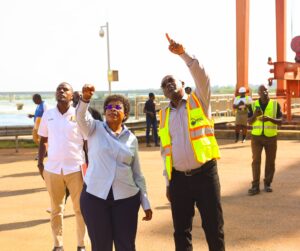
IGG, Beti Kamya and Eng Harison Mutikanga
Opening the spillway gates beyond 40% causes dangerous vibrations throughout the dam structure, increasing fears that a major flood event could wash away the powerhouse and related structures downstream.
UEGCL’s project manager at Isimba, Eng Chad Akita, explained that inspections conducted in 2022 and again in 2024 revealed extensive concrete erosion, washouts of buffer blocks, and the widening of slab gaps, all of which continue to worsen.
“Another inspection was conducted in 2024 by the contractor. And that inspection confirmed that these defects are still existing,” Akita revealed.
“They are still existing, they are increasing from the evidence collected. These include gaps within the slab, we have concrete erosion within the bottom slab. And the main concern here is that the enforcement continues to be enforced,” he added.
Akita said that among the requirements of a spillway is the need to withstand extreme water pressures and the capacity to manage floodwaters.
“The risks are increasing and we need to take some action quickly,” he said.
It emerged that the way the component of the spillway was designed makes it very difficult to maintain. The contractor has to hire divers to go underwater in case of maintenance. Two divers died at the spillway after the August 2022 flooding, which led to the temporary closure of the dam.
URN learned that there had been attempts to carry out underwater repairs on the spillway, but the work was suspended in February 2024, because of increased water discharge on River Nile.
Engineer Harrison Mutikanga said he always gets sleepless nights because of Isimba dam whenever it rains.
“Because when you have a spillway that is likely not to deal with its flood design capacity, and then you are getting a lot of rain, then you can’t stop worrying. Especially now that the spillway has defects that compromised its functionality,” explained Mutikanga, a civil engineer.
It had been hoped that the contractor would have embarked on long-term spillway rehabilitation works. There were no such rehabilitations by the time the IGG visited Isimba.
UEGCL officials at the site said that the contractor was “dillydallying”. Our reporter, however, witnessed men dressed in orange overalls on top of the powerhouse. Assisted by a yellow crane, the workers were reportedly repairing leakages on the roof of the power house.
At the time of commissioning in March 2019, Isimba dam had over 700 defects. These included leakages in the powerhouse roof, cracks in the powerhouse, internal erosion of the embankment dams, lack of a log boom, poor cabling in the powerhouse among others.
It is suspected the dam, which was constructed using embankment technology, has manifested persistent defects because of either poor materials that are not resisting erosion, wear and tear.
Apart from erosions and concrete damages at the spillway, it has also been observed that the water cooling systems at Isimba are not up to standard. Experts on site say these could have severe consequences, including reduced operational efficiency, increased maintenance costs, and potential damage to equipment.
The damages being reported by UEGCL were allegedly acknowledged by CIWE in December 2024. UEGCL has indicated that CIWE has been inconsistent with its presentation of the condition of the dam.
The manager in charge of CIWE at Isimba was not on site at the time when Kamya and her team visited. She was informed that the manager had travelled to China, where he had gone to conduct a physical model test (PMT) to determine the root cause of the structural issues at the third spillway.
Former Energy and Mineral Development minister, Eng Irene Muloni had assigned a team of experts led by a structural engineer, Prof John Senfuma, to investigate the shoddy works at Isimba. The team had reportedly warned that the dam could burst because of the defects.
While at Isimba, Kamya was asked why she was taking an interest at the particular moment and her possible line of investigation into the matter.
Observations from IGG
Kamya expressed alarm at the state of the dam, noting that it looked much older than its actual age. She also pointed to a worrying disconnect between UEGCL and the contractor, CIWE, regarding the seriousness of the defects and the strategies needed for repair.
“And I think that is a big problem because you can both agree. Yes, we haven’t delivered, but we can deliver,” she said.
“There seems to be a different appreciation of the gravity of the problem of the defect of the strategy to employ to redeem the problem. So I think that is a very a big problem that needs to be resolved,” she said.
Contractor and supervision challenges
CIWE, the Engineering, Procurement, Construction, and Commissioning (EPCC) contractor, has been accused of poor workmanship. Despite evidence confirming the defects, rehabilitation efforts have been sluggish.
Repair works, including attempts to fix leakages on the powerhouse roof, were ongoing during the IGG’s visit, but comprehensive spillway rehabilitation had not yet begun. Criticism has also been directed at Energy Infratech Pvt Limited (EIPL), the Indian firm contracted by the government to supervise construction at Isimba and Karuma dams.
EIPL was suspended from the project in 2017 following President Museveni’s directive, after investigations revealed its failure to provide sufficient technical supervision, leading to material quality compromises and poor construction standards.
EIPL’s contract expired on September 7, 2017, after 40 months effective from May 7, 2014. A project steering team led by Eng Badru Kiggundu in 2017 found that EIPL did not mobilize experienced key supervision personnel including quality control specialists, electromechanical specialists and an experienced geotechnical engineer to fully lead in supervision of construction of the embankment dams, in spite of repeated recommendation and calls to fill the agreed project supervision structure.
“This compromised the construction control aspects and, in some instances, led to non-conformance related to material placement and dam monitoring instrumentation for both the left and right embankment dams,” Kiggundu explained in 2017.
According to Kiggundu, the biggest undoing was the change of materials for electro-mechanical and hydro-mechanical equipment.
“Whereas the EPC contract and employer requirements clearly specified the material properties for equipment like gates, draft tubes, stop logs, cooling system, etc, these were changed to materials of lower or inferior grade compared to what was specified in the contract, under the watch of EIPL.
URN established that despite the suspension of EPIL’s services, the government continued to pay it until its contract expired.
Past warnings and continuing risks
Concerns about Isimba’s structural integrity are not new. A team of experts, led by structural engineer Prof John Senfuma, had previously warned that the dam could be at risk of collapse if defects remained unaddressed.
Reports now suggest that issues with the water cooling systems could further degrade the dam’s operational efficiency and safety. Kamya said her office would assess the information gathered and deliver a preliminary report within three weeks.
“We will look into whether someone is culpable,” she stated. “We always make people take responsibility, but for now, the petitions were about the quality of work. Maybe the problem was supervision who slept on the job supervising the contractor?”
**********adopted from URN**************
Comments




